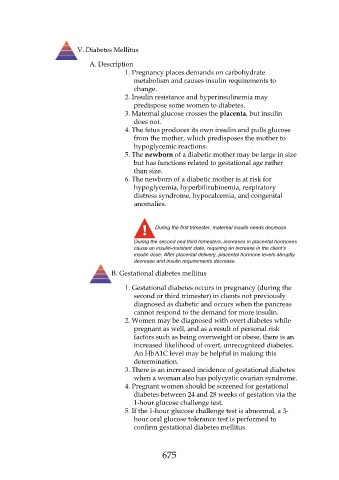Page 675 - Saunders Comprehensive Review For NCLEX-RN
P. 675
V. Diabetes Mellitus
A. Description
1. Pregnancy places demands on carbohydrate
metabolism and causes insulin requirements to
change.
2. Insulin resistance and hyperinsulinemia may
predispose some women to diabetes.
3. Maternal glucose crosses the placenta, but insulin
does not.
4. The fetus produces its own insulin and pulls glucose
from the mother, which predisposes the mother to
hypoglycemic reactions.
5. The newborn of a diabetic mother may be large in size
but has functions related to gestational age rather
than size.
6. The newborn of a diabetic mother is at risk for
hypoglycemia, hyperbilirubinemia, respiratory
distress syndrome, hypocalcemia, and congenital
anomalies.
During the first trimester, maternal insulin needs decrease.
During the second and third trimesters, increases in placental hormones
cause an insulin-resistant state, requiring an increase in the client’s
insulin dose. After placental delivery, placental hormone levels abruptly
decrease and insulin requirements decrease.
B. Gestational diabetes mellitus
1. Gestational diabetes occurs in pregnancy (during the
second or third trimester) in clients not previously
diagnosed as diabetic and occurs when the pancreas
cannot respond to the demand for more insulin.
2. Women may be diagnosed with overt diabetes while
pregnant as well, and as a result of personal risk
factors such as being overweight or obese, there is an
increased likelihood of overt, unrecognized diabetes.
An HbA1C level may be helpful in making this
determination.
3. There is an increased incidence of gestational diabetes
when a woman also has polycystic ovarian syndrome.
4. Pregnant women should be screened for gestational
diabetes between 24 and 28 weeks of gestation via the
1-hour glucose challenge test.
5. If the 1-hour glucose challenge test is abnormal, a 3-
hour oral glucose tolerance test is performed to
confirm gestational diabetes mellitus.
675

